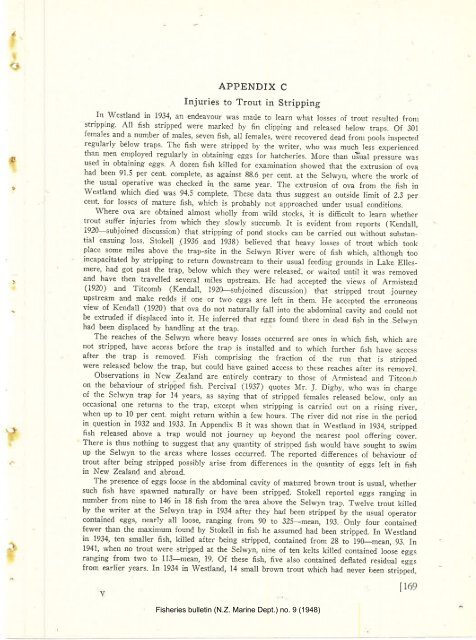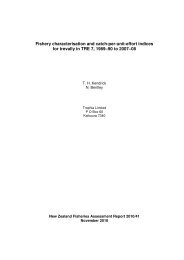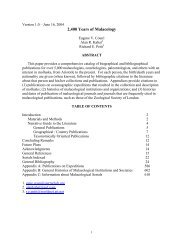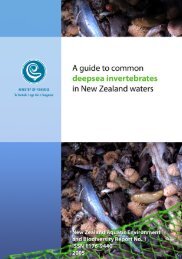N.Z. MARINE DEPARTMENT-FISHERIE,S BULLETIN No. .į
N.Z. MARINE DEPARTMENT-FISHERIE,S BULLETIN No. .į
N.Z. MARINE DEPARTMENT-FISHERIE,S BULLETIN No. .į
Create successful ePaper yourself
Turn your PDF publications into a flip-book with our unique Google optimized e-Paper software.
fl<br />
tf<br />
-ì<br />
APPENDIX C<br />
Injuries to Trout in Stripping<br />
In W'estland ]n 1934, an endeavour was macle to learn what losses of trout resu;ltecl fronr<br />
stripping' All fish stripped were m¿rrkecl by fin clipping and released belorv traps. Of 301<br />
fer¡ales and a number of males, seven fish, all females, were recoverecl clead froni pools inspectecl<br />
regularly below traps. The fish were stripped b1' the writer, who rvas much less experienced<br />
than men employed regularly in obtaining eggs for hatcheries. More than ,**al prersr.,.. *",<br />
usecl in obtaining eggs' A dozen fish kílled for examination showecl that the extrusion of ova<br />
hacl been 91.5 per cent complete, as against 88.6 per cent. at the selwyn, where the work of<br />
the usual operative was checked in the same year. The extrusion of ova from the fish in<br />
Westland which died was 94.5 complete. These data thus suggest an outside limit of 2.3 pet<br />
ceut. for losses of mature frsh, which is probably not approachecl under usual conditio¡s.<br />
Where ova are obtained almost 'wholly from wild stocks, it is difficult to lean whether<br />
trout suffer injuries from which they s1ow1y succumb. It is eviclent from reports (Kenclall,<br />
192O-subjoined cliscussion) that stripping of poncl stocks can be carried out without substantial<br />
ensuing loss. Stokell (7936 and 1938) believecl that heavy losses of trout which took<br />
place some miles above the trap-site in the Selwyn River were of fish which, although too<br />
incapacitated by. stripping to return downstream to their usual feecling grou¡cls in Lake Ellesmere,<br />
had got past the trap, below q,hich they were released, or waited until it was removecl<br />
and have then travelled several miles upstream. He hacl accepted the views of Armistead<br />
(1920) and Titcomb (Kendall, 1920-subjoinecl cliscussion) that strippecl trout jour¡ey<br />
upstream and make redds if one or two eggs are left in them. He acceptecl the erroneous<br />
view of Kendall (1920) that ova do trot naturally fall into the abdominal cavity and could not<br />
be extruded if displaced into it. He i:nferrecl that eggs founcl there in clead fish in the Selwvn<br />
had been displaced by handling at the trap.<br />
The reaches of the Selwyn where heavy losses occurrecl are ones in which fish, which are<br />
not stripped, have access before the trap is installed ancl to which further fish have access<br />
after the trap is removed. Fish r:omprising the fraction of the run that is strippecl<br />
were released below the trap, but cotLld have gainecl access to these reaches after its removal-<br />
Observations in New Zealand' are entirely contrary to those of Ar¡risteacl a¡cl Titcon.n<br />
on the behaviour of stripped fish. Percival (1937) quotes Mr. J. Digby, who was in charge<br />
of the Selwyn trap for 14 ¡'ears, as saying that of strippecl females releasecl below, only a¡<br />
occasional one returns to the trap, r:xcept when stripping is carriecl out on a rising river,<br />
when up to 10 per cent. might return within a few hours. The river clid ¡ot rise i¡ the perio¿<br />
in question in 7932 and 1933. In Appr:ndix B it lvas shown that in Westlancl in 1934, stripped<br />
fish released above a trap would not journey up beyoncl the nearest pool offering cover.<br />
There is thus nothing to suggest that any quantity of stripped fish woulcl have sought to swim<br />
up the Selwyn to the areas where losses occurred. The reporte







